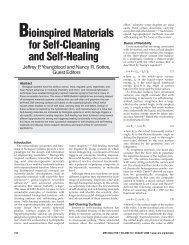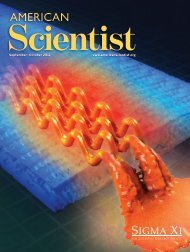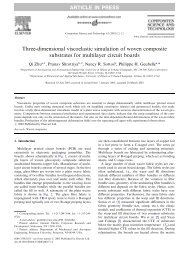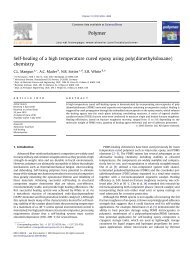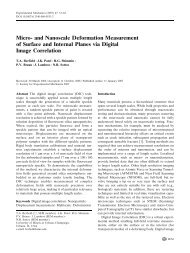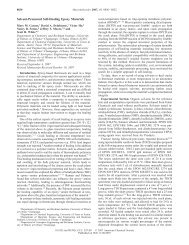Effect of microcapsule size on the performance of self-healing ...
Effect of microcapsule size on the performance of self-healing ...
Effect of microcapsule size on the performance of self-healing ...
Create successful ePaper yourself
Turn your PDF publications into a flip-book with our unique Google optimized e-Paper software.
J.D. Rule et al. / Polymer 48 (2007) 3520e3529<br />
3525<br />
Fig. 7. Influence <str<strong>on</strong>g>of</str<strong>on</strong>g> <strong>the</strong> catalyst crystal morphology <strong>on</strong> <strong>healing</strong> <strong>performance</strong><br />
with manually applied DCPD. The catalyst used in <strong>the</strong> specimens had been<br />
recrystallized through ei<strong>the</strong>r n<strong>on</strong>-solvent additi<strong>on</strong> or freeze-drying.<br />
Fig. 6. Fracture planes after <strong>self</strong>-<strong>healing</strong> <str<strong>on</strong>g>of</str<strong>on</strong>g> specimens c<strong>on</strong>taining (a) 20 wt%<br />
<str<strong>on</strong>g>of</str<strong>on</strong>g> <str<strong>on</strong>g>microcapsule</str<strong>on</strong>g>s with an average diameter <str<strong>on</strong>g>of</str<strong>on</strong>g> 63 mm or (b) 10 wt% or <str<strong>on</strong>g>microcapsule</str<strong>on</strong>g>s<br />
with an average diameter <str<strong>on</strong>g>of</str<strong>on</strong>g> 386 mm. The polyDCPD has been darkened<br />
to enhance c<strong>on</strong>trast.<br />
<str<strong>on</strong>g>of</str<strong>on</strong>g> about 2 mm and lengths <str<strong>on</strong>g>of</str<strong>on</strong>g> more than 10 mm, and <strong>the</strong>y possess<br />
a good blend <str<strong>on</strong>g>of</str<strong>on</strong>g> fast dissoluti<strong>on</strong> and less deactivati<strong>on</strong> [22].<br />
The effect <str<strong>on</strong>g>of</str<strong>on</strong>g> catalyst crystal morphology <strong>on</strong> <strong>healing</strong> <strong>performance</strong><br />
is summarized in Fig. 7. It is important to note that<br />
while <strong>the</strong> <str<strong>on</strong>g>size</str<strong>on</strong>g> and morphology <str<strong>on</strong>g>of</str<strong>on</strong>g> <strong>the</strong> catalyst crystals vary,<br />
<strong>the</strong> wax microspheres in which <strong>the</strong>se crystals are embedded<br />
are all <str<strong>on</strong>g>of</str<strong>on</strong>g> approximately <strong>the</strong> same average <str<strong>on</strong>g>size</str<strong>on</strong>g>. Therefore,<br />
<strong>the</strong> catalyst-bearing microspheres in all experiments have<br />
a similar level <str<strong>on</strong>g>of</str<strong>on</strong>g> dispersi<strong>on</strong> in <strong>the</strong> epoxy matrix in spite <str<strong>on</strong>g>of</str<strong>on</strong>g><br />
<strong>the</strong> fact that <strong>the</strong> catalyst crystals embedded in <strong>the</strong>se microspheres<br />
may be different. The larger crystal morphology associated<br />
with n<strong>on</strong>-solvent additi<strong>on</strong> significantly improved <strong>the</strong><br />
<strong>healing</strong> <strong>performance</strong>. Greater energy-to-failure and peak loads<br />
were achieved using less <strong>healing</strong> agent than for <strong>the</strong> freezedried<br />
catalyst morphology. Hence, <strong>healing</strong> <strong>performance</strong> can<br />
be enhanced through more efficient delivery <str<strong>on</strong>g>of</str<strong>on</strong>g> catalyst and<br />
efficient use <str<strong>on</strong>g>of</str<strong>on</strong>g> available <strong>healing</strong> agent.<br />
4.2. <str<strong>on</strong>g>Effect</str<strong>on</strong>g> <str<strong>on</strong>g>of</str<strong>on</strong>g> crack <str<strong>on</strong>g>size</str<strong>on</strong>g><br />
Since <strong>self</strong>-<strong>healing</strong> <strong>performance</strong> is impacted by delivery <str<strong>on</strong>g>of</str<strong>on</strong>g><br />
sufficient <strong>healing</strong> agent for <strong>the</strong> crack volume to be repaired,<br />
smaller crack volumes should exhibit reduced requirements<br />
<str<strong>on</strong>g>of</str<strong>on</strong>g> <strong>healing</strong> agent delivery. To test this hypo<strong>the</strong>sis, a modified<br />
fracture specimen was designed. All previous experiments<br />
were performed with cracks that propagated all <strong>the</strong> way to<br />
<strong>the</strong> end <str<strong>on</strong>g>of</str<strong>on</strong>g> <strong>the</strong> TDCB specimens. The two halves <str<strong>on</strong>g>of</str<strong>on</strong>g> <strong>the</strong> specimen<br />
were clamped back toge<strong>the</strong>r after initial fracture in a way<br />
that does not exert any force to press <strong>the</strong> crack faces back toge<strong>the</strong>r,<br />
but <strong>on</strong>ly places <strong>the</strong> two halves in c<strong>on</strong>tact. This procedure<br />
results in an average crack face separati<strong>on</strong> <str<strong>on</strong>g>of</str<strong>on</strong>g> about<br />
26 mm near <strong>the</strong> loading pin holes <str<strong>on</strong>g>of</str<strong>on</strong>g> <strong>the</strong> sample. A modified<br />
TDCB sample incorporates a crack-directing groove that is reduced<br />
from 47 mm l<strong>on</strong>g to 25 mm l<strong>on</strong>g (Fig. 1). As a result,<br />
when <strong>the</strong> specimen is initially fractured, <strong>the</strong> virgin crack propagates<br />
<strong>on</strong>ly until it reaches <strong>the</strong> end <str<strong>on</strong>g>of</str<strong>on</strong>g> <strong>the</strong> groove. The sample<br />
is <strong>the</strong>n unloaded and set aside to allow <strong>self</strong>-<strong>healing</strong> to occur.






